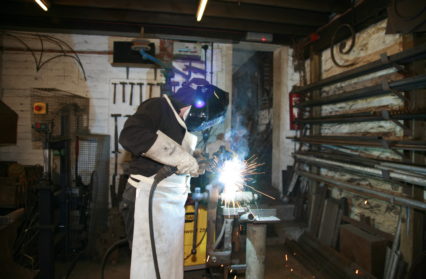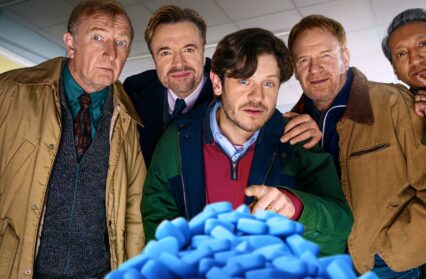Candy Bedworth hears from sculptress, blacksmith and activist Spike Blackhurst, getting her perspective on everything from inspiration and artistic process to the lessons of COVID and finding acceptance in Wales.
Pioneering artist Spike Blackhurst is reshaping what we know about 3D sculpture and designing cutting edge tools and processes to fuse metal and ceramics. She is also asking challenging questions about the role of the artist within society.
Any artist or engineer will tell you that combining metal and ceramics is extremely difficult – nigh on impossible. Undaunted, Spike Blackhurst decided that she would devote her MA to exploring just that. And the result is a breath-taking exhibition, containing sculptures that explore the tension between fragility and strength, whilst adding to the national discourse on emotional abuse and trauma.
We visited Spike Blackhurst’s blacksmithing workshop in Llanbrynmair, to view her latest project ‘Against All Odds’ and discuss her approaches to her art.
In love with process
“I’m a process artist – for me the fun is in the making. Perhaps even more important than the final piece. I draw on tradition – I light my forge with paper and wood, but I also use angle grinders and welders. I follow in the footsteps of ancient Japanese ceramics masters in my use of Raku, but I have invented new tools to handle the clay.”
Blending
“The premise of my Masters degree at Wrexham University was how to blend two completely different materials – an experiment, pushing the boundaries of what is possible. One of the materials I am very familiar with – metal. But I have always wanted to dive into ceramics. I was very lucky with my peer group at University – two professional ceramicists, Jane Sams and Tara Squibb, fast-tracked me in how clay works, and what I could do with it.”
Wiggle room and happy accidents
“I work well if I don’t know the limitations. For me that is a world of wonder, I find the limits as I explore, I push the boundaries. The two materials shouldn’t really have worked together – ceramic shrinks as you fire it, metal doesn’t. Ceramics are not as forgiving as metal. If I make a mistake with metal, I can re-weld it. If ceramic shatters, you start again. There are mathematical equations for this ‘wiggle room’ – but sometimes you just have to go on your intuition. See what happens!”
Raku
“I spent the first year of my MA just playing with materials and colour. You can do some fascinating tricks with glazes on clay. But every step involves risk. Essentially, with raku, the initial firing takes all the moisture out of the clay. Then I add a wet or dry glaze, and it goes back in the kiln at 750-950 degrees. I watch through the little kiln window until the glaze looks like treacle. Then it goes into a metal bin full of sawdust, and the reaction brings out the glaze, followed by a thermal shock as it enters water. Every step could involve an explosion – a nerve wracking process ceramists go through every time with every piece. I designed a set of tools for handling the pieces, and then made them in my blacksmithing forge. It’s part of my nature – a blacksmith is always looking to improve or develop their tools.”
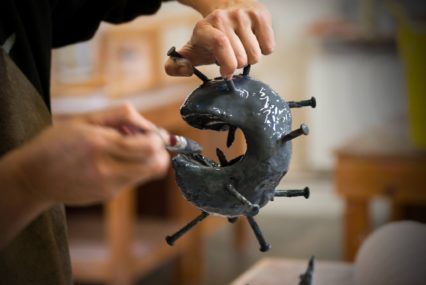
Bodies and trauma
“My MA sculptures focus in on bodily organs, what they represent to us and how they hold the trauma of emotional abuse. I feel domestic abuse can be misrepresented and misunderstood, and certainly the law does not yet fully acknowledge its full range and impact. l wanted to explain that experience visually, to embrace and explore the beauty and the grotesqueness of our minds and bodies. My work is political – I want to change the law. I have been a political activist in the past, using anger and direct action. Now I want to use my intelligence and my art to promote change. I’m trying anyway.”
Communicating the human condition
“My art is very different to my blacksmithing. This work is extremely personal. I am dyslexic, I can struggle with words, so visualising something is how I communicate and connect. Maybe someone can look at my work and think, yes, that’s how I feel. The more we can share our stories, if that feels comfortable, the more we can help move on the debate. I researched, I spoke to counsellors, I spoke to people who live with trauma, and reflected on my own experiences.”
Philosophy
“I’m not a fan of plinths and the traditional ways of displaying ‘art’. My work isn’t precious in that sense. I want visitors to see my work in the round, to walk right up to it, to explore it.
I try to dispel the mystique about the artistic process: exposition – show your workings! I always have test pieces, spares and mistakes on show – these are part of the process and are as important as the finished piece that goes on display. Even as I’m developing pieces in the workshop, people can see them, ask about them. I welcome criticism – your work can always be better, and other people’s perception and reality is fascinating to me.”
Art as therapy
“Since childhood, art has been my healing place to work through pain. I am always happy to talk about my philosophy and my work. I give a trigger warning, of course, that I refer to emotional trauma in this series. But the amount of people who open up, share stories, even become friends is heartening. It is cathartic beyond belief. Five years ago I escaped an abusive relationship, I was lucky. But it’s taken a long time to let go, to put it into my work in a positive way. Now I work with Welsh Women’s Aid and support the White Ribbon campaign.”
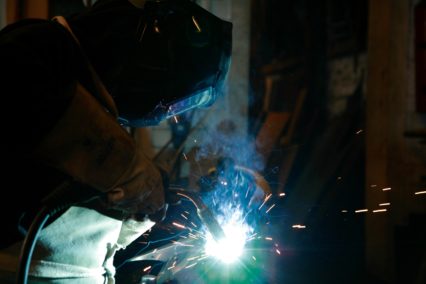
Autobiography
“Against All Odds is not just a stand-alone sculpture exhibition, it is ever evolving. With amazing support from tutors at Wrexham University, I am working on a book, describing my journey both personally and professionally. My hope is that it might inspire artists, especially ceramicists and blacksmiths, but also be of interest to people who have experienced trauma. Anyone with dyslexia out there may be surprised to know that I actually enjoy writing now!”
What’s next?
“Tools of the Revolution is my next big project – the result of five years of work. I’m looking at what makes humans ‘good’ or ‘bad’ – what do we mean by that? What are the positive qualities we look for? I’m interested in expressing authenticity, empathy, conscience. I would love to work collaboratively with other artists who also want to communicate and raise awareness. To explore the fragility of humankind, but in a beautiful way.”
Covid lessons
“Strangely enough, Covid taught me about love. I helped take care of two people – one going through cancer treatment and one in palliative care. It was amazing to see the unconditional support that is available within our small Welsh communities. I shut up shop for a few months, completely stopped work – I’ve never done that in 20 years. I was very lucky to be able to afford to do it. It meant I could help with transporting a friend to cancer treatment sessions – I could totally shield and be there for her. And it was wonderful to be with my uncle when he died, to be present in the room, to be there for him and his family.”
“To be honest I stayed busy even without work – I have this rule to learn something new every day – and that’s so easy with access to google and YouTube. I also got grubby, I love gardening and growing. I joined the Future Leaders Programme with Welsh Assembly, studying women who lead with empathy – fascinating. I had never before understood or acknowledged that I have leadership qualities myself. We don’t realise the value of what we do until we stop and reflect. To be honest, it was always hard for me to take compliments without crying or feeling awkward – I’ve only just learnt that in the last two years. Future Leaders really boosted my confidence and I am now a Role Model for Welsh Assembly Government.”
Teacher and Mentor
“I qualified as a teacher a few years back. What surprises me is that how we teach has hardly changed since the industrial revolution – I teach very differently. I’m still learning, and I learn from my students. There is always still something new out there. Whatever else I do, I want to teach for the rest of my life. It keeps me humble, it keeps me inspired. My advice to anyone wanting to join education – go for it, find your passion.”
“What do I need to know first before I start teaching someone? I need to know how that person learns. Connect first, find a common denominator, then you’ll see their passion ignite. Then we have something to work with that is authentic. That’s my job as a teacher. I have a blacksmithing apprentice now. And I offer bursaries to students who can’t afford to study. Where they are born, their economic circumstances, shouldn’t starve their creativity. I started my business with a grant, a scholarship and a loan. Without those three things, I wouldn’t be here today.”
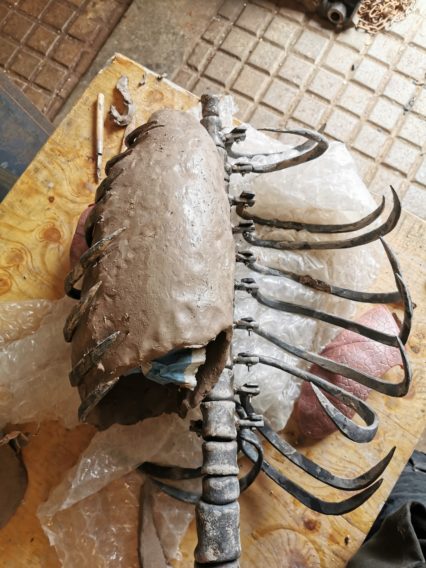
Art today
“I have a strong work ethic, I have worked since I was 13, I always made sure I had an income. But you can’t quantify art with money. I make slow art. I pride myself on being a tortoise. I crave technical proficiency. In all of my studies, I got my hands dirty, I learnt skills, I served my time. That’s why I spent 20 years of my life practising the craft of blacksmithing.”
“I studied Fine Art at Bath University in the 1990s and I saw so much conceptual bollocks – people could talk an awful lot of crap about something they hadn’t even made! If you pay someone else to make your art – what have you learned? You’ve learned how to spend money. I want something to be the best I can possibly make it. I work at the point where art and craft and design meet to create magic. It’s a beautiful marriage.”
“I abhor the snobbery of those who don’t even know their own medium very well. It’s not just about ideas, it’s time spent creating. Whether that is with voice, poetry, sculpture etc.
There are too many charlatans in the art world, and not enough quality. For instance – look at Damien Hirst or Anthony Gormley. Their business-based studios dilute their gift and talent. I feel they have lost the buzz, the tingle. That feeling that you get, making something in the moment, it surpasses everything else. It’s also a healing place to be.”
Inspiration
“Everything inspires me: the river outside my house, my cat, my partner, my students. Nature and the human condition I suppose. Artist Meri Wells has held my hand and her work inspires me. Her animal poses are incredible, all her creatures seem alive, and her influence is embedded in my work. I adore the work of Louise Bourgeois – she worked til she was 98! She was extremely and exactly herself – such a courageous woman. I’d like to do an enormous sculpture like her some day.”
“Halloween is my hobby, my favourite day of the year. I love horror – I have an electric chair and coffins upstairs in my workshop. I was raised by my Nan and Grandad in Ilford, Essex – they taught me kindness and creativity. I was a real tomboy. My Nan bought me a pram and I used it as a wheelbarrow for transporting sand. I designed castles and forts and grandad built them. I still have lot of my grandad’s tools and I use his vice in my daily practice.”
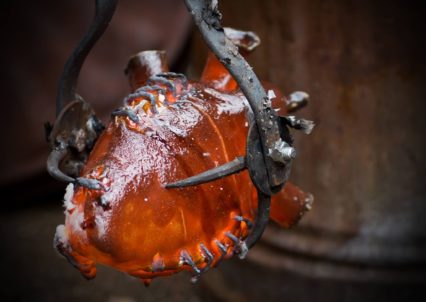
Settling in Wales
“I have spent my life being judged: as a tomboy; as a punk; as a goth; as a traveller; as a gay woman. But I’ve learnt to be myself. I feel adopted Welsh. This is least judgemental place I have ever lived. Lots of people in my home town in Essex experienced sexism, racism, homophobia. I travelled all over. I left Devon in a hurry as I’d been threatened with fire-bombing. I arrived in Wales with dreads in my hair and spikes in my face, but they saw through that and went straight to my heart. I got a warm welcome from day one. I’ve found my place and I am incredibly grateful to be here.”
Learning from my mistakes
“My blacksmithing tutor gave me a piece of advice I still use both in my art and in my daily life. I was this skinny little student, wielding a huge blacksmithing hammer. And he said ‘it doesn’t matter how strong you are, it’s all in the technique.’”
“When I mess up, I giggle. I say to myself: oops, ok, I’ll learn something from this. If I really lose my mojo, I put on a bit of Bee Gees and dance round the workshop. Music gets me through the tough times. I listen to Nick Cave and PJ Harvey. Seeing Nina Simone live inspired me to play the piano again. If I’m having a really stuck day, I go home. And I say that to my students or apprentices too. If you’re having a bad day, go home, go to bed, watch TV, cook something nice. Health and well being is much more important than work.”
What does success look like?
“This! I’m living the dream. When I was begging for food in Spain, I never imagined I’d be here with my workshop, financially secure for the first time in my life, with amazing friends and students. Every day I’m grateful to walk through the door of this workshop – it’s my sanctuary. I want to continue to make my art, to exhibit, to teach – to make a difference.”
Against All Odds exhibition pieces:
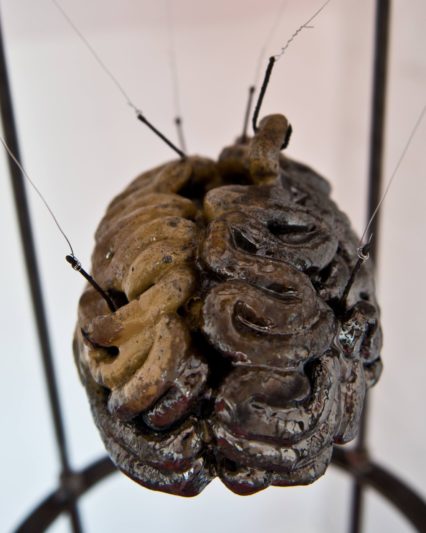
The brain
“Most people in abuse situations are experiencing some form of mind control. The current use of the word gas-lighting does not even go halfway to explaining this trauma. The brutal fish hooks bite through the flesh of the brain, and are suspended by wires. How do you release the brain? If you cut through the wire and hooks, it will crash to the floor. It takes a long time to calm and repair the triggers that have traumatized the mind. I developed a metal suspension frame, like the medical frame that holds a broken leg in place while it heals.”
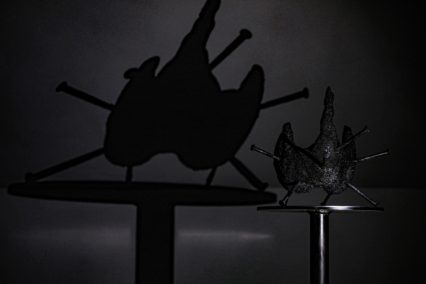
The voice
“This piece is about the stifling of the voice, being shouted at, being shamed into silence. Research seems to show that emotional trauma and stress can affect the thyroid gland, which is hormone controlled. I am now a part of the Thyroid Trust, working on awareness raising with them. This piece references tribal fetish dolls and voudou poppets. The nails push through the thyroid, stifling the voice. The glaze was another happy accident. I visited the International Ceramics Festival in Aberystwyth – brilliant festival, I highly recommend it! I purchased a new kind crackle glaze but left it on the clay too long. Very fortuitous however, as it turns out I discovered a brand new glaze no-one has ever seen before. The piece may look quite grotesque, but when a torch shines on it, it sparkles and shines like a diamond. We do need to love these parts of ourselves that are dysfunctional or damaged.”
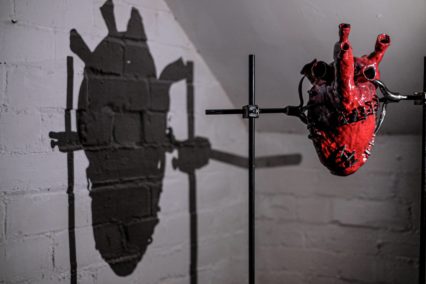
Love
“Here we have the broken heart, in blood red raku. It looks a little Frankenstein (I was brought up on Hammer House of Horror, thank you Grandad!). I made the piece in sections and held it together with metal staples. It is supported within rib cage retort stands I made in the forge – the kind of thing you’d find in a chemistry lab where precious or fragile materials are held in those metal arms. There is a beautiful song by the singer Skye Edwards, where she tells us, we are “not broken, but loose at the seams”. I love that imagery. Our hearts get broken, and will always have scars, but they tell our history.”
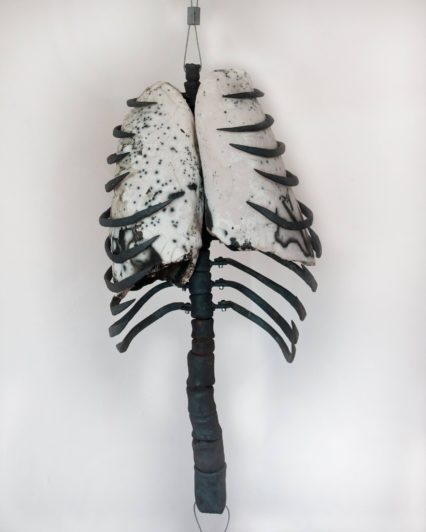
Anxiety
“The ribcage was my trickiest piece – I had no idea if it would work. I forged an articulated rib cage to hold and restrain the lungs, but I knew that once I fired ceramic lungs, they would shrink. Would the piece fit together and hold? Although it creaked and moaned as I put it together, it worked! It all added to the magic of the production I suppose. The piece is hung from the roof by a cable, then secured by a weight at the bottom, to show the ribcage held in tension, in suspension, as in our own bodies. We hold emotion in our spine, in our backs. I left ribs in their dirty forged state, I didn’t clean them up – anxiety is raw.”
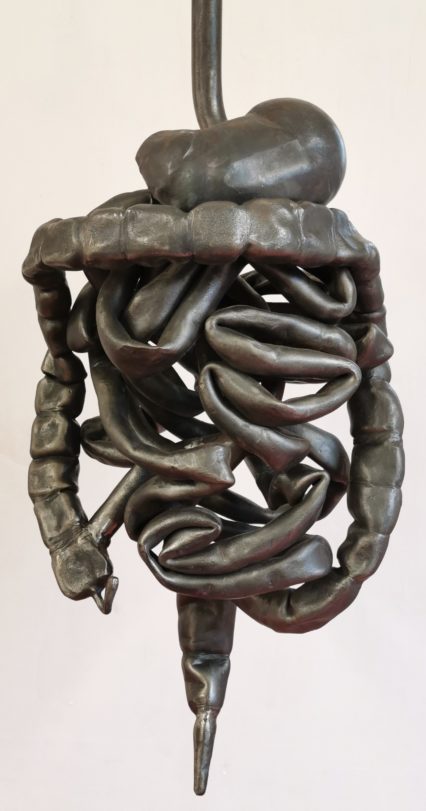
Gut reactions
“The final piece in the series is the most positive. It is what saved me. We all have it – intuition or gut feeling. We know when things don’t feel right, but we do things out of love or duty or fear. Despite my love of horror, I have always been squeamish about what is inside the body, so now was the time to face that. I joined the forensic degree department for a while in Wrexham University. I looked at body parts and how they work. Wow, what an experience – our bodies really are amazing. This is the most technically challenging forged piece I’ve ever made, it is free-standing, and it looks soft but it’s sturdy. So many cultures believe that courage comes from the belly, and that is what I’m exploring with this piece.”
Spike Blackhurst studied Fine Art at Bath University, specialising in sculpture and bronze and aluminium casting. She studied Blacksmithing at Hereford, did a teaching degree at Newtown College and completed her Masters degree at Wrexham University.
To see more on Spike’s art visit her website. You can also find her discussion of wider issues via WordPress.
Candy Bedworth is a regular contributor to Wales Arts Review.


